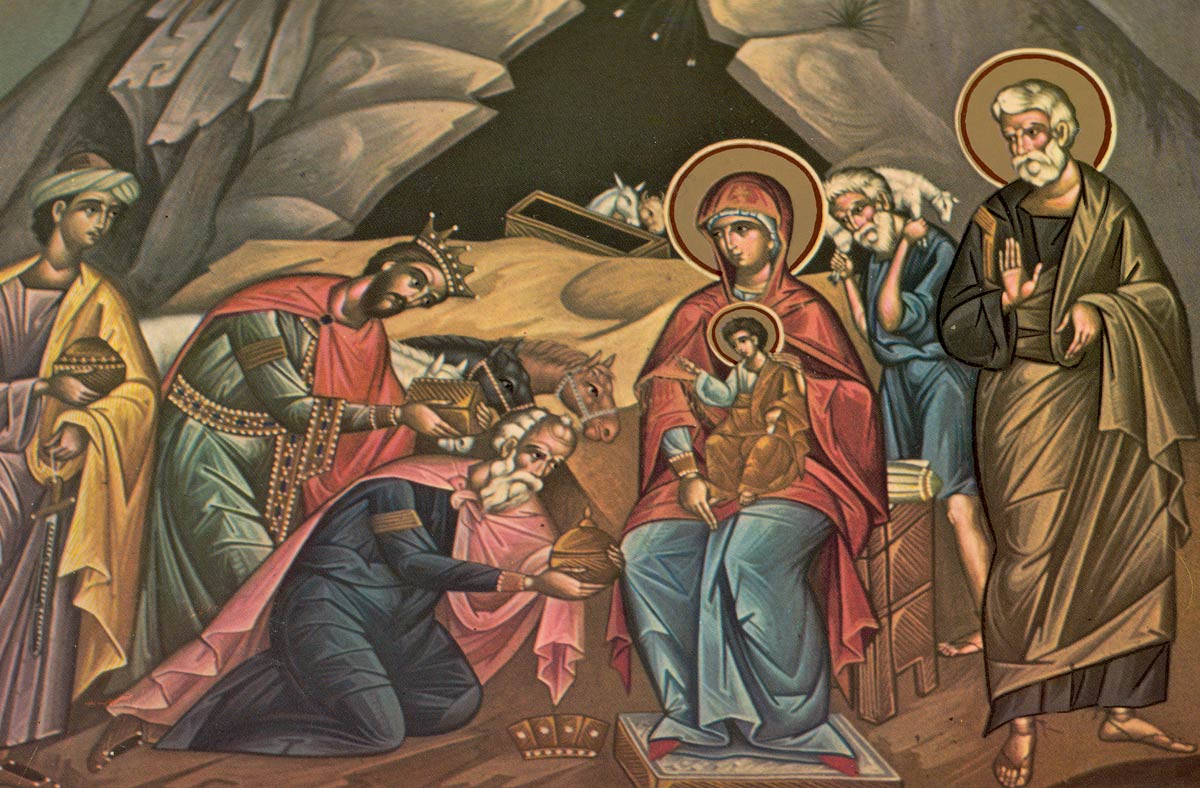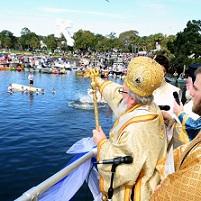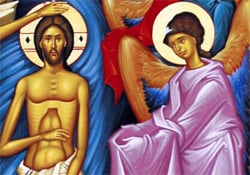The commemoration of the Nativity of our Lord, the Baptism of our Lord, and the events related to them developed over time in the life and practice of the Church. Originally celebrated together on the same day, their celebrations - and the sequence of 12 days in between them - offers the faithful a festal period of great joy.
History
As they designated dates to commemorate events in Jesus’ life, the early Christian Church selected January 6 as the date to observe both the birth and baptism of Christ. In the early 4th century it was felt by the church leadership that a distinction should be made between the two observances. They selected Dec 25 to be the date to celebrate the birth of Christ and kept Jan 6 to be the baptism.
The selection of Dec 25 also addressed a second issue. The end of December was filled with pagan gatherings and festivities (in honor of the “sun god” as he became victorious over the “god of darkness” as the days slowly began to become longer (the winter solstice). Christians were falling back to pagan temptations with these festivities, thus the church fathers wanted to provide them with their own reason to celebrate. This reason of course became the birth of the Son of God (who made the sun).
Once Christmas Arrives
Our Orthodox Church today celebrates highly and with great festivity and joy! Once Christmas arrives on December 25, we enter a new liturgical period. The major period runs 40 days, from Jesus' Birth to His 40 day Presentation to the Temple (Feb 2). Within these 40 days is some sub-division.
From December 25 to January 6, there became a 12-day period from the one major celebration to the next major observance. Thus, we have the “12 days of Christmas” that bridge the birth with the baptism and it became a festal period of time of great joy and celebration. As time progressed January 6 began to be called the “little Christmas.”
We have the 7 day Christmas tide which are part of the 12 Days of Christmas, focusing on immediate events up to His naming & Circumcision on the 8th day (January 1). Henceforth, we begin to prepare for the observance of His Baptism when He was 30 years old.
The Baptism of Our Lord
In the Orthodox Church January 6 is officially called the Baptism of our Lord – Theophany (sometimes called simply Epiphany). Theophany means “God’s appearance” and Epiphany simply “appearance”. On the day of Jesus’ baptism, the Holy Trinity was made manifest with the appearance of the dove and the voice that was heard from the sky (Matt 3:13 – 17).
The Catholic Church later in history changed January 6 to be the arrival of the Wise men and made the Baptism to be the Sunday after January 6. In our Orthodox observances, the arrival of the Wise men is combined on the same day as the birth. The Armenian Church still retains January 6 as their Christmas commemoration.
The Twelve Days of Christmas
These 12 days that comprise the “12 days of Christmas” also include other observances on various levels. The first level are events that are directly associated to Christ’s birth in the flesh, including the murder of the 14,000 baby boys that Herod ordered when Jesus was born (December 29) and the 8-day naming of Jesus (January 1).
A second level of observances during these 12 days are commemorations of people from the earliest decades of the spread of the Christian faith after the death and resurrection of Christ and Pentecost, such as St. Stephen (one of the first of the 7 deacons) who became the first martyr in Christianity (December 27); and the “seventy” as they are known, these being the 70 apostles that the 12 apostles trained and sent off to travel and preach (January 4).
The third level of commemorations of these 12 days are for those who in later centuries lived and honored Christ in marvelous ways and became saints of the church, such as St Melanie of Rome from the 5th century (December 31), St Basil the Great from the 4th century era (January 1), and St Sylvester, Bishop of Rome also from the 4th century (Jan 2).
In its development over many centuries, the twelve days of Christmas that we celebreate today have become a theological and historical cornucopia of both the life of Christ and the life of the Church through its Christian Witness. What follows is a brief review of the themes from each of the twelve days of Christmas.
Day 1 - Dec 25 - The Nativity in the Flesh of our Lord, God and Saviour Jesus Christ
The Shepherd's worship and the visit of the wise men from the East.
Day 2 - Dec. 26 - Synaxis of the Virgin
Gives Glory and Praise to her, who bore our Lord. Also on the 26th is the commemoration of the Flight into Egypt when an angel warned Joseph of King Herod's plans to kill the children in Bethlehem.
Day 3 - Dec. 27 - St. Stephen the Deacon and 1st Martyr
He was the 1st of the 7 deacons in the “start up” Christian Church (Acts 7) who was stoned to death by the Jews, in 34 A.D. Tradition says that the Theotokos & St. John the Theologian witnessed the stoning.
Day 4 - Dec. 28 - 20,000 Martyrs of Nicomedia (men, women and children)
An event in 302 AD when the wicked Emperor Maximian Hercules, while visiting in Nicomedia learned of the large number of Christians living there and devised a means to get rid of them. It was the days preceding Christmas that he visited so, on Christmas, as the Christians were in church….his soldier’s surrounded the church, so no one could leave. The Emperor's envoy gave them a choice to deny Christ and offer sacrifice to the pagan idols, or, be burned to death. The congregation chose death (in fact catechumens were quickly baptized). The soldiers set fire on all 4 sides of the church and the building burned for 5 days The smoke had a fragrant scent and a golden light surrounded the church.
Day 5 - Dec 29 - 14,000 children of Bethlehem (Holy Innocents)
King Herod was furious hearing from the wise men about a new born King in Bethlehem, and ordered that all the babies, 2 yrs and under to be killed in Bethlehem and the surrounding area. This occurred, 1 yr. after the birth. Herod sought out Zachariah's son, also newly born (John, who later became the Baptizer of Jesus) thinking that John would be the “New King”. When Zachariah refused to hand over baby John, Herod killed Zachariah as he also killed Simeon who had received Christ as the 40 day old baby Jesus. Angered with the Jews in general – Herod also killed Hyrcanes, their high priest and 70 elders from the Sanhedrin (their council). Herod was so enraged that “someone” would take his position – he also killed own brother and sister, as well as his wife and 3 of his sons! What a crazed man!
Day 6 - Dec 30 - Deacon Timon (one of the 7 Deacons)
Also counted as one of the 70 Apostles who became Bishop in Arabia. He died by crucifixion there in the third century (298AD). On the same day we have the martyrdom of St Anysia from Thessaloniki, born of wealthy and prominent parents. She was orphaned young. She assisted the poor and devoted herself to prayer and fasting. This was the time of Emperor Maximian Hercules again. One of his decrees was that anyone was free to kill Christians when and where they came across them, without trial or sentences. So as Anysia was out in the streets one day, a soldier approached her and confirmed through direct conversation with her, that she was a Christian. He ran her through with a knife under her rib and killed her. This was actually during the days that the pagans had their festival of the sun god (which ultimately became later on in history the date selected for the observance of Christ’s Birth).
Day 7 - Dec 31 - Nothing directly connected to Christmas per se, but 2 important figures of the 4th and 5th Century who witnessed greatly to Christian living.
4th Century - Martyr Zoticus, Protector of the Poor
A priest in Constantinople, who had a home for the poor and those with infectious diseases. He was a close acquaintance of Emperor Constantine the Great. Constantine’s son (Constantine) was jealous of all the money his dad gave to Zoticus to help the poor and the sick, that he tied Zoticus to the behind of a wild ass and he ultimately died of his wounds.
5th Century - Holy Mother Melanie of Rome
Born to wealthy parents, she was forced to marry a young nobleman. After having 2 children she convinced him that they should live as brother and sister. Their 2 children died some time later and they agreed to give their possessions to the poor and the church. They traveled as well to many far away places doing good works along the way. She ultimately became a nun at the Mt. of Olives in Jerusalem.
Sunday After Christmas - Honor is given Joseph the Guardian (i.e. also called Righteous Joseph), David the King (the son of Jesse) and Iakovos, the (step-brother) of Christ, the 1st bishop of Jerusalem.
Day 8 – Jan 1st - Circumcision and Naming of Jesus
In observance of Jewish Law since the time of Abraham, Joseph and Mary took baby Jesus to the Temple for circumcision and he was also given the name “Jesus”, the name announced to Mary at the time of the annunciation by Archangel Gabriel (Luke 1:31). This act of circumcision showed that Jesus took true human flesh upon Himself, (not its resemblance as heretics’ would later say about him).
Also on Jan 1st, St. Basil the Great is remembered. Born around 330 A.D. under the reign of Constantine the Great. As an un-baptized person, Basil spent 19 years in Athens studying philosophy, rhetoric, astronomy and other secular disciplines. In his mature years, he was baptized in the Jordan River. He became ultimately Bishop of Caesarea in Cappadocia, died unfortunately young, at age 50. He was a great champion of the faith of moral purity and a great theological mind.
Day 9 - Jan 2nd - St. Sylvester, Bishop of Rome
At the age of 30 he was elected a bishop and served for 20 yrs/died in 335 A.D. He is the one attributed for bringing St. Helen to the Christian faith and ultimately King Constantine himself. He also is credited with “reforming” the Saturday fast (that it would not be a strict fast day) making only Holy Saturday a strict Saturday of fasting.
Jan. 2nd also remembers St. Theodota the mother of the brothers St. Cosmas and Damian, the unmercenary and miracle working doctors.
Day 10 - Jan 3rd - Prophet Malachi (500 yrs. before Christ)
Malachi, is the prophet who prophesied the coming and the mission of John the Baptist (Malachi 3:1). In fact there was no prophet between Malachi and John. Malachi also prophesied about the dread judgment, against ungrateful Israel and against the lawless Hebrew priests.
January 3rd also remembers Martyr Gordius. Born in Caesarea of Cappadocia/an officer in the Roman Army in the reign of Emperor Licinius. After the Army, he went to Sinai (to Mt. Horeb) in contemplation and prayer. He was stabbed to death in 320 A.D.
Day 11 - Jan 4th - Synaxis of the 70 Apostles
This day honors these men, that Jesus also selected that followed the 12 Apostles (Luke 10:1-11), sending them out 2 by 2 going to every city before He himself has to go. This was similar to the Old Testament period in that Moses also had 70 elders that he appointed - Exodus 18:21, 22; 24:1. The 70 Apostles offered valuable service to Christ in those earliest of years as missionaries.
Day 12 - Jan 5th - Hieromartyr Theopemptos, Bishop of Nicomedia and also Martyr Theonas (a pagan magician)
This was the era of Emperor Diocletian who persecuted Christians. When Theopemptos was brought before the Emperor, he responded to the Emperor’s request to deny Christ, by quoting Scripture - (Matt 10:28) “Fear not them who kill the body, who are unable to kill the soul." Then he added - do unto my body as you please. Diocletian sent his magician to trick and outdo the bishop...when Theonas saw that even poison would not hurt the Bishop, he converted to Christ! Theopemptos was then beheaded 298 A.D. Theonas was buried alive 298 A.D.
The Glorious Observance of the Baptism of Our Lord
Jan 5 - The Paromony / Preparation (Strict Fast)
Jan 6 - The Baptism Observance
Jan 7 - Synaxis in honor of St John the Prophet, Forerunner and Baptist
Certainly, these 12 days are of great significance and should be known, honored and lived rightly.



